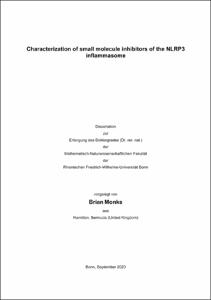Monks, Brian: Characterization of small molecule inhibitors of the NLRP3 inflammasome. - Bonn, 2021. - Dissertation, Rheinische Friedrich-Wilhelms-Universität Bonn.
Online-Ausgabe in bonndoc: https://nbn-resolving.org/urn:nbn:de:hbz:5-63406
Online-Ausgabe in bonndoc: https://nbn-resolving.org/urn:nbn:de:hbz:5-63406
@phdthesis{handle:20.500.11811/9255,
urn: https://nbn-resolving.org/urn:nbn:de:hbz:5-63406,
author = {{Brian Monks}},
title = {Characterization of small molecule inhibitors of the NLRP3 inflammasome},
school = {Rheinische Friedrich-Wilhelms-Universität Bonn},
year = 2021,
month = aug,
note = {To respond quickly to infection, the innate immune system contains many germline encoded pattern recognition receptors (PRRs) that recognize a myriad of danger signals released by pathogens and damaged tissues. NLRP3 (nucleotide-binding oligomerization domain, leucine rich repeat and pyrin domain containing 3) is a cytosolic PRR that responds to a broad range of activators, including bacterial pore-forming toxins, extracellular ATP and monosodium urate crystals. Activation of NLRP3 leads to the recruitment of ASC (apoptosis-associated speck like protein containing a caspase recruitment domain) forming a large oligomeric protein platform called the inflammasome. The inflammasome recruits procaspase-1, which is then activated by autocleavage. Active caspase-1 cleaves several know targets, including the interleukin-1 family cytokines, leading to their release as mature active cytokines. Gasdermin D (GSDMD) is also cleaved by active caspase-1, leading to a type of cell death termed pyroptosis. Gain-of function mutations, leading to hyperactive NLRP3 were found to be the cause of a spectrum of systemic autoinflammatory diseases termed cryopyrin associated periodic syndrome (CAPS). NLRP3 activation has also been shown to be a key factor in the severity of chronic diseases involving aggregate or crystalline substances, such as gout, atherosclerosis, and Alzheimer’s disease.
Several factors have been shown to be important for activation of NLRP3, such as reactive oxygen species (ROS) and potassium efflux, but the exact mechanism that mediates the response of NLRP3 to its diverse triggers is poorly understood. A further complication is the requirement in macrophages for an initial step, termed priming, in order to be NLRP3 competent. In this step, NLRP3 protein level is increased by the induction of transcription, and then is post translationally modified in several ways, such as deubiquitination and dephosphorylation for full function. Separating inhibition of priming verses inhibition of NLRP3 activation can be difficult.
To study direct small molecule inhibition of NLRP3, a mouse NLRP3 Knockout cell line was used that constitutively expresses NLRP3, removing the need for priming, and also expresses fluorescently tagged ASC to allow detection of inflammasome formation. This cell line was used to screen two commercially available small molecule libraries for the ability to inhibit NLRP3 activation.
In order to identify the domain of NLRP3 targeted by inhibitors, several chimeric receptors were constructed which contained the pyrin domain of NLRP3 or AIM2. Upon activation, these receptors interact with ASC through the pyrin domain, allowing them to induce the condensation of ASC into a single speck within the cell.
In this study, I could show that several NLRP3 inhibitory compounds resulting from these screens, and several previously identified NLRP3 inhibitors, were able to inhibit the ability of chimeric receptors containing the pyrin domain of NLRP3, but not the pyrin domain of AIM2, to initiate ASC speck formation.},
url = {https://hdl.handle.net/20.500.11811/9255}
}
urn: https://nbn-resolving.org/urn:nbn:de:hbz:5-63406,
author = {{Brian Monks}},
title = {Characterization of small molecule inhibitors of the NLRP3 inflammasome},
school = {Rheinische Friedrich-Wilhelms-Universität Bonn},
year = 2021,
month = aug,
note = {To respond quickly to infection, the innate immune system contains many germline encoded pattern recognition receptors (PRRs) that recognize a myriad of danger signals released by pathogens and damaged tissues. NLRP3 (nucleotide-binding oligomerization domain, leucine rich repeat and pyrin domain containing 3) is a cytosolic PRR that responds to a broad range of activators, including bacterial pore-forming toxins, extracellular ATP and monosodium urate crystals. Activation of NLRP3 leads to the recruitment of ASC (apoptosis-associated speck like protein containing a caspase recruitment domain) forming a large oligomeric protein platform called the inflammasome. The inflammasome recruits procaspase-1, which is then activated by autocleavage. Active caspase-1 cleaves several know targets, including the interleukin-1 family cytokines, leading to their release as mature active cytokines. Gasdermin D (GSDMD) is also cleaved by active caspase-1, leading to a type of cell death termed pyroptosis. Gain-of function mutations, leading to hyperactive NLRP3 were found to be the cause of a spectrum of systemic autoinflammatory diseases termed cryopyrin associated periodic syndrome (CAPS). NLRP3 activation has also been shown to be a key factor in the severity of chronic diseases involving aggregate or crystalline substances, such as gout, atherosclerosis, and Alzheimer’s disease.
Several factors have been shown to be important for activation of NLRP3, such as reactive oxygen species (ROS) and potassium efflux, but the exact mechanism that mediates the response of NLRP3 to its diverse triggers is poorly understood. A further complication is the requirement in macrophages for an initial step, termed priming, in order to be NLRP3 competent. In this step, NLRP3 protein level is increased by the induction of transcription, and then is post translationally modified in several ways, such as deubiquitination and dephosphorylation for full function. Separating inhibition of priming verses inhibition of NLRP3 activation can be difficult.
To study direct small molecule inhibition of NLRP3, a mouse NLRP3 Knockout cell line was used that constitutively expresses NLRP3, removing the need for priming, and also expresses fluorescently tagged ASC to allow detection of inflammasome formation. This cell line was used to screen two commercially available small molecule libraries for the ability to inhibit NLRP3 activation.
In order to identify the domain of NLRP3 targeted by inhibitors, several chimeric receptors were constructed which contained the pyrin domain of NLRP3 or AIM2. Upon activation, these receptors interact with ASC through the pyrin domain, allowing them to induce the condensation of ASC into a single speck within the cell.
In this study, I could show that several NLRP3 inhibitory compounds resulting from these screens, and several previously identified NLRP3 inhibitors, were able to inhibit the ability of chimeric receptors containing the pyrin domain of NLRP3, but not the pyrin domain of AIM2, to initiate ASC speck formation.},
url = {https://hdl.handle.net/20.500.11811/9255}
}






